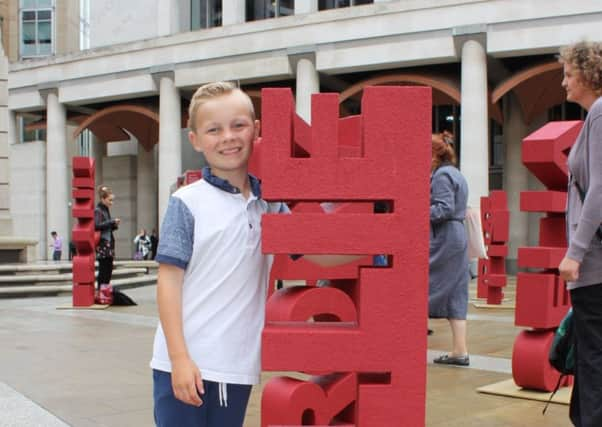Hastings boy's fight with leukaemia told in large art installation


Ollie Harrison, eight, is one of 104 people with blood cancer, chosen from across the UK, to have their story told as part of the installation in Paternoster Square to mark Blood Cancer Awareness Month.
The installation represents the 104 people who are diagnosed with the disease every day in the UK, raising public awareness and making their experiences visible by telling their individual stories.
Advertisement
Hide AdAdvertisement
Hide AdOllie was diagnosed with a combination of both acute lymphoblastic leukaemia and acute myeloid leukaemia in October 2012, when he was just three.
After abnormal blood tests he was sent by ambulance to the Royal Marsden Hospital and began chemotherapy.
He responded well to treatment and after a month tests showed he was in remission.
But Ollie developed kidney failure shortly afterwards and a string of infections resulted in long periods of hospital stays. His treatment lasted more than three years, finishing in January last year.
Advertisement
Hide AdAdvertisement
Hide AdThe installation, next to St Paul’s Cathedral, marks the launch of the Make Blood Cancer Visible campaign, supported by blood cancer research charity Bloodwise and eight other similar charities and patient support groups.
Ollie’s name, constructed in three dimensions at his exact height, with a summary of his blood cancer experience, features alongside other patients’ names and stories and plinths highlighting facts about blood cancer. The pharmaceutical company Janssen commissioned artist Paul Cocksedge to create the installation, which is available for the public to visit until September 30.
Ollie’s mum, Emma, who is a patient ambassador for Bloodwise, said: “Ollie’s older brother Daniel still fears when Ollie goes for check-ups. I try to put it all behind me but I am continually worried about the leukaemia coming back. Blood cancer is not only one of the most common cancers, it is also one of the bigger cancer killers. Because many of the symptoms can be unspecific, they are often confused with other, less serious conditions, meaning people go misdiagnosed for longer, which can affect treatment options and outcomes for them. Luckily for Ollie, his only symptom set alarm bells ringing for the professionals and he was diagnosed quickly. That said, at diagnosis, his bone marrow was packed with leukaemia cells, making it difficult to say how long it had been there.”
Alasdair Rankin, director of research at Bloodwise, said: “We are delighted to be a part of this exciting campaign to raise awareness of blood cancer. It is a complex disease area and public awareness of many different types of blood cancer is limited. We’ll be working with our researchers, clinicians and of course patients and carers across the UK to help raise awareness throughout September. It is great to see so many charities joining forces on this campaign and making blood cancer visible.”
Around 39,000 people are diagnosed with blood cancers and related disorders every year in the UK.